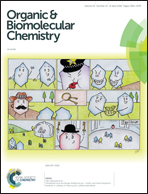A QM/MM approach on the structural and stereoelectronic factors governing glycosylation by GTF-SI from Streptococcus mutans†
Abstract
In this work, QM/MM calculations were employed to examine the catalytic mechanism of the retaining glucosyltransferase GTF-SI enzyme, which participates in the process of caries formation. Our goal was to characterize, with atomistic details, the mechanism of sucrose hydrolysis and the catalytic factors that modulate this reaction. Our results suggest a concerted mechanism for sucrose hydrolysis in which the first event corresponds to the glycosidic bond breakage assisted by Glu515, followed by the nucleophilic attack of Asp477, leading to the formation of the Covalent Glycosyl Enzyme (CGE) intermediate. A novel conformational itinerary of the glucosyl moiety along the reaction mechanism was identified: 2H3 → 2H3–E3 → 4C1, and the calculated energy barrier is 16.4 kcal mol−1, which is in good agreement with experimental evidence showing a major contribution coming from the glycosidic bond breakage. Our calculations also revealed that Arg475 and Asp588 play a critical role as TS-stabilizers by electrostatic and charge transfer mechanisms, respectively. This is the first report dealing with the specific features of the mechanism and catalytic residues involved in GTF-SI hydrolysis of sucrose, which is a matter of relevance in enzyme catalysis and could be valuable to aid the design of novel and specific inhibitors targeting GTF-SI.

- This article is part of the themed collection: Mechanistic, computational & physical organic chemistry in OBC


 Please wait while we load your content...
Please wait while we load your content...